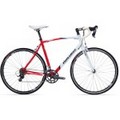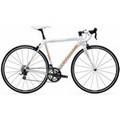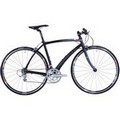
France is a country that fills a bicyclist dreams. It offers wide, empty roads and beautiful rolling countryside. And the landscape resembles a bouquet of vivid colors.
What You Need to Know About
Bicycling in France
When to go Getting there Lodging/Food Bicycles
Regions
Alsace Brittany Burgundy Centre-Loire Champagne
Dordogne Languedoc Normandy Poitou-Charentes
From the dramatic, historical coast of Normandy to the vast vineyards scattered throughout the country, bicycling in France is legendary. You will be entering a country the size of Texas, but boasting six national parks, 137 natural reserves and 32 regional natural parks. France offers the bicyclist a choice to experience the beauty of its natural resources or to live amongst its provincial charm. The cuisine may be legendary, but the bicycling is fantastic.
When to Go
In most parts of France, except the northeast and mountain regions, the climate is predominantly temperate. The French Alps can be hot, cold, cool, and wet all in the same day. The northeast has hot summers and cold winters. The southern coastal plains boast a Mediterranean climate with sudden downpours in the spring and autumn months but rain almost absent in the summer. The south has a relentless cold, dry wind, called the ‘mistral’, in the spring that blows down the Rhône Valley.
Here are some suggested times for bicycling in France:
- Southern France: May and September
- Middle and Northern France: June, July, August, and September
- High mountain regions: July and August
- Provence Region: May, early June, late September, and early October
- Loire Valley: June through September
- Dordogne River Area: May, early June, late September, and early October
- Alsace: May through early October
How to Get There and Beyond
Overseas flights usually land at the Charles De Gaulle, which is about 25 km northeast of the center of Paris. The majority of the time, European flights will use Orly airport, which is about 15 km south of the center of Paris. Nice airport is another alternative for some local flights.
France is one of the easiest countries to travel by train. Its TGV trains hold the world’s friction rail speed record at 357 mph (575kmph). Rail lines, stretching some 19,188 miles (30,880km), go almost anywhere—and rapidly.
The trains are clean, comfortable and economical. Visit Rail Europe’s web site for routes, schedules, and costs. Unfortunately, most of the high-speed, long-distance trains do not carry assembled bicycles. Consequently, the bicycle will have to be transported as baggage, which may require a box or case.
The regional express trains (RER) can be crowded at times, but you can bring an assembled bicycle on board. If your bicycle is still packed in a box, you may have long distances to transport your bicycle when changing trains. You can visit the RATP website for more information.
Lodging and Food
During the summer tourist season, hotels should be reserved months in advance. From mid-July to the end of August, you probably need to seek reservations almost a year in advance. This five to six week period can be extremely busy in the tourist areas due to the school holidays and most people taking their summer vacations. Fortunately, the prime bicycling in France months of late spring, early summer, and early fall should offer a large selection of rooms. During this time, you may be able to get a room the day of your visit in a lot of the towns. Either call ahead or stop at the local tourist office when you first get in town to check on room availability. The offices are excellent for working with cyclists.
In recent years, ‘agritourism’ has become popular all over Italy. This type of tourism is orientated around having a rural experience which you share with the family who owns the farm or agritourism on which you are staying. Generally, these properties are vineyards or orchards and you are able to enjoy the fruits of the farm and in many cases your meals are prepared in traditional settings and dishes by the family itself. Many converted farmhouses in the Italian countryside will receive guest for one or multiple nights. Many will offer an evening meal with the room. Staying in an agritourism home provides you with a perfect situation to experience Italian farm life.
Try these sites for information and reservations for agritourism overnight stays:
- Reids Guides
- AgriSport
And of course, you can check out the typical hostels that are located all over Italy: Hostel World.
Food and wine in France are a way of life. In most eating establishments, they buy only fresh food, usually obtained at the local market that day. Just like all the local food, you need to try the local wines. The prices will be fair and the choices abundant. If you want to visit some of the wineries, you may need to call in advance. Many of the wineries are closed to visitors without prior approval. In October, even the visitor friendly wineries may be closed during the fall grape harvest. But you can enjoy all the local wines at the cafes and bistros during your bicycling in France route.
Your Bicycle
The type of bike that you will need for bicycling in France depends on your planned route. In general, the roads are well paved and without potholes. In rural France, you will find quite a few dirt and gravel roads. So it is best to check with your tour operator to make sure of your ride. In fact, most of the tour companies rent or supply bicycles with their tours. Common types of bicycles available include hydbrid, touring road, and mountain bicycles.
Generally, a hydbrid or touring bicycle with wide tires (say around 28 to 36mm) will handle most roads. Mountain bikes will work for road touring if you switch out the very wide tires to something closer to 36 to 40mm wide. I would strongly recommend that you stick with a touring triple for the hills in the countryside. Some of the hills can be quite steep and long for a double crankset. And if you’re going to bicycle in the Alps, the mountain triple crankset would be a better choice.
If you need to rent a good bicycle from a local bike store, you may be out of luck unless you are in Paris, the Loire Valley, the Dordogne River area, or Provence. Most of the commercial renters at local shops or railroad stations usually rent lower quality bicycles. Any trip over a day may not be a good choice for these bicycles. If you do find a reason ride, you will probably have to supply your own bags and computer. Helmets are usually part of the rental fee. Some suggestions include:
- Bike Rentals Plus: Quality bikes (including tandems) and they delivery to your hotel, airport, or train station. They have over 100 locations in Italy and France.
- Aquitaine Bike Hire Dordogne: Quality touring, road and hybrid bikes in Dordogne region.
- Aquitaine Bike Hire Dordogne: Quality touring, road and hybrid bikes in Provence and the Mt Ventoux region.
- Cycling Classics: Mainly a tour company, but they rent quality bikes on an as available basis.
Alsace
Alsace is situated between the beautiful Vosges mountains in France and the borders of Germany and Switzerland. As a result, the region has the combined cultures of these three countries. Half-timbered houses with carved stone porches dot the cities and countrysides. You will ride on cobbled stone roads that wind through medieval towns, see castles on hilltops, and experience the solitude of ancient monasteries.
Between Strasbourg and Colmar, the famous Route du Vin strings together about 100 wine producing villages. Gourmet cuisine reigns in this region, and you can eat at many Michelin star restaurant. All in all, bicycling in Alsace is an everlasting experience.
Brittany
This coastal region is known for fine beaches and sheer cliffs. It is a rugged region with spectacular coastlines, islands and inland woods. In the seaside resort of Carnac, megalithic remains from the Neolithic period stand. The area is studded with burial places, semicircles, and tumuli. And the medieval city of Vannes is a perfect base from which to explore the inland sea and its many islands.
This region is a major supplier of vegetables and seafood. Local obtained oysters, shrimp, crayfish, lobster, crab, and scallops ensure fresh seafood in the local markets and restaurants. This area has only about a dozen frost days a year. Consequently, early vegetables, fruits, and flowers are abundant in this region and are shipped across France.
The interior is a relatively barren, often misty, plateau called Argoat. Hedgerows surround small fields, resulting in a picturesque landscape called bocage. Here you will quaint towns with cobble-stoned streets and a medieval fortified village. Brittany beckons with beauty, a diverse culture and amazing cuisine.
Burgundy
Your bicycling in France tour wouldn’t be complete without a visit to the Burgundy region. Burgundy is the land of fine art and living. It has been a crossroads for the north of Europe and to the routes to Italy, which influenced its varied cultures. Vineyards stretch for miles along the south sloping hills. And in the valleys cattle and dairy farms are in abundant. Cheeses and fresh products are plentiful.
The Saone, Yonne, and Loire rivers have smoothed the lowlands amongst the gentle rolling hills. Oaks, maples, and pines cover many of the hillsides. And fields of poppies and sunflowers color the lowlands.
The Burgundy Canal winds along the plains and rises steeply with a concentration of stair-like locks. It is a navigable waterway that connects the north of Europe to the Mediterranean sea. The canal still float cargo carrying vessels, but and people-carry luxury vessels dominates today.
Centre-Loire Valley
The Loire River is the last untamed river in Europe. It can be calm and still; it can be wild and fast. You will see inlets and wild flowers, shifting sandbanks and wild beavers. Yet, gorgeous chateaux dot the river and picturesque villages sit around the banks. The pathways along the river invite you by foot and/or bike.
The Centre Loire Valley was a key region in the Middle Ages and the cradle of the Renaissance. Here you can see the biggest castle of the Renaissance, the Chateau of Chambord, located in the middle of a vast forest. Numerous other examples of royal life are scattered throughout the region. The life in the towns and villages reflects the culture from its long history. You can stroll around the towns and discover its ancient roots.
The valleys of the region are covered with prairies of fruited vineyards. This region is wine country: Muscadet, Vouvray, Bourgueil, and many others. And south of the Loire River, the Sologne is planted with pines. Fishing and hunting is popular in this area.
Champagne
Champagne is a historic province in the northeast portion of the country. As the name implies, it is best known for the production of the sparkling white wine. The region is a chalk plateau with vineyards stretching over the rolling hillsides. Picturesque villages dot the countryside. Most of the vineyards lie between Reims and Epernay. Only the sparkling wines that are produced in this region can rightly be called Champagne.
Throughout the centuries, 25 kings of France were crowned in the Reims’ cathedral. Fittingly, the kings and guests were served champagne, which eventually became the drink to celebrate special events. Today beneath the Avenue de Champagne, over 90 million bottles of champagne lie. If you want to taste champagne, many of the wine tasting houses offer tours of their caves and tasting rooms.
You can visit the fortified towns of Langres, Sedan, and Troyes. Sedan has the colossal medieval fortified chateau that has survived intact from numerous medieval attacks.
Dordogne
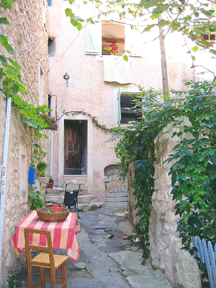
For the perfect bicycling in France, a beautiful winding valley of gentle greenery has been carved out. This is the Dordogne region of France. This southwest region is one of the most beautiful and popular tourist destinations of France. Chateaux, forest and gardens, medieval towns and villages, rivers and caves, and unspoiled countryside await the bicyclist.
In the village markets, the fruit and vegetables, nuts, and mushrooms of every description bear witness to the region’s self-sufficiency in food. Here, foie gras and truffles are everyday fare, and every town has shops filled to overflowing with these local treasures. Other local specialties are confit of duck and goose, walnut cakes, chocolate-dusted walnuts, and walnut wine and liqueur. Local wines include Monbazillac, Bergerac, and Pecharmant.
Although the Dordogne is beautiful throughout the year, it is most beautiful in the spring. Then the many fruit orchards are in bloom. In the fall the light is rich and the landscape alive with color. In July and August, it is very crowded, and bicycling through the riverside villages in particular can be frustrating.
Languedoc
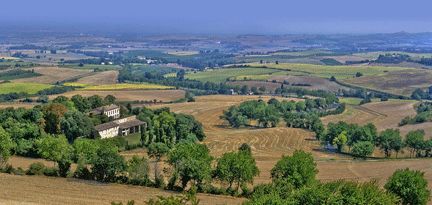
The Languedoc Region is one of the most fascinating areas of Europe. It borders the Mediterranean Sea to the east and the Pyrenees Mountains to the south. It benefits from an exceptional Mediterranean climate and has an unusually rich wildlife, a spectacular coast, and wonderful countryside.
If you are planning on bicycling in France, the Languedoc region should be one of your top priorities. You will see mountains, rivers and lakes, ancient cities, towns, villages, thermal springs, abbeys, cathedrals, châteaux and castles.
Two distinct areas divides the Languedoc region: the plains of the Bas (Lower) Languedoc and the rugged terrain of the Haute (Upper) Languedoc, towards Provence and the Alps. The Haute Languedoc is a sparsely populated, mountainous area, the refuge of successive waves of exiles and refugees over the centuries. It includes the Parc National des Cévennes. The Bas Languedoc is a popular destination during the mid-July and August French holiday vacations. So be warned for this time period.
Normandy
The Normandy region of France is located in northern France along the English Channel between Picardy on the east and Brittany on the West. It has a 360-mile dramatic coastline, including the dramatically evocative World War II landing beaches. The interior countryside has lush farmland, bustling market towns, and historic landmarks such as the cities of Caen, Bayeux and Rouen.
Local production is predominantly agricultural, producing milk, butter, and cheese; apples; grain; thoroughbred horses; and calvados, an apple brandy. Camembert cheese is a local specialty. Local fare tends to be made with a lot of cream and butter: Normandy is not really the place to come for nouvelle cuisine. Camembert, seafood, cider and Calvados should all be on your list of taste sensations for this region.
If you fancy a day at the seaside, the coast line in Normandy is very varied. You could choose to visit the windswept D-day landing beaches near Bayeux or the overdeveloped seaside resorts of Trouville and Deauville, or Fécamp. More appealing are the pretty towns of Honfleur and Barfleur, and the villages along the banks of the Seine. The Côte d’Albôtre has chalk cliffs and pebble beaches. You’re certain to enjoy this region as you bicycle through the green pastures and seaside towns, discovering the history that has made this area so famous.
Poitou-Charentes
For bicycling in France, the Poitou-Charentes region is not as well known. However, this region offers an immense array of opportunities. Bicycling in this region is about discovering a peaceful and diversified countryside, with its rich heritage of history, architecture, and traditions.
At first glance the long ribbon of sandy coastline, bathed in sunshine during the summer months, of Poitou-Charentes has something of the southern Mediterranean about it. But as you get to grips with the region you notice the influence of the Atlantic creeping in. The resorts may be less glamorous than in the south but historically they ‘re much better looking.
Inland, the countryside has an early morning dewy quality of moistness, the fields are lushly green, the rivers are softer and the population evenly spread. Around Cognac the glow of the vineyards crowned by the individual châteaux, produce the famous golden elixir. To the north, the Marais Poitevin – nicknamed the “Green Venice” – is France’s version of a warmer less wind swept Norfolk Broads. It’s a dream world of river boulevards and emerald coloured shimmering reflections.
Provence
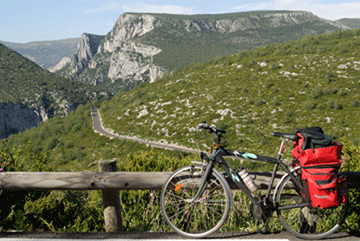
For the ultimate tour in France try Provence. It has beautiful vistas, charming towns and villages, and ancient Roman influences. The roman arenas, theaters, and monuments are found in the heartland of Provence, the mainly flat, rich farmland near the Rhone River. One of the most beautiful areas of Provence is the Luberon region. There among the hills, perched villages overlook the agricultural plain.
Bicycling in Provence is mainly side road and minor highways with light traffic. Most of the towns have light to moderate urban traffic. The city of Nimes may have heavy city traffic. Generally, bicycling in the core of Provence is fairly easy with small slopes and rolling hills. Just be cautious of the mistral winds in early spring.
Provence is rural country and each day is market day there. One of the largest olive plantations in France is located in this region. It’s not just olives that you see along the road though, There are lots of other goods such as cheese, bread, sausage and preserves And of course, wine is a staple drink there because it is also one of the contents of a Mediterranean diet.
Rhône-Alpes
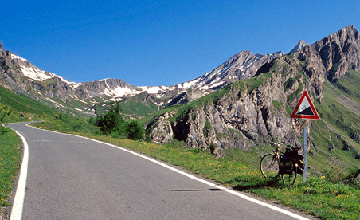
Rhône-Alpes is a succession of vastly different landscapes, from the snow-covered, world-famous alpine ski resorts to marvelous valley vineyards, endless olive groves and spectacular cities packed with architectural gems.
The high mountain regions are to the east; the river Rhône Valley is in the center; and the hills of the Ardeche are to the west. This region can be the ultimate for bicycling in France with varying terrain. Whether it is mountain biking or road touring, you will find excellent bicycling. There is heavy industry along the Rhone valley, but also agriculture and wine with Beaujolais and Côte du Rhone.
The mountains rise steadily from Lac Leman (Lake Geneva) and keep climbing to the year-round ice-capped tip of Mont Blanc, the highest peak in Europe. In the winter it’s a white-washed world of snowcapped peaks and icy lakes where everyone takes to the ski-slopes. In the summer months it’s an entirely different place where you can enjoy the lowland pleasures of mountain biking through flower-filled meadows or swimming in the lakes. There are several national parks including the Parc National De La Vanoise, which is a wild mix of high mountains, steep valleys, and glaciers.
The Beaujolais area north of Lyons is a land of pastures and forests. This area is mostly famous for its wines. The vineyards are found along on a 60km narrow strip of terraces on the right bank of the River Saône. Beaujolais also produces many oils – not just olive oil, but pecan nut, almond and pine kernel oil. The Parc Naturel du Pilat, south of Lyons, offers stunning panoramic views across the Rhône Valley.
